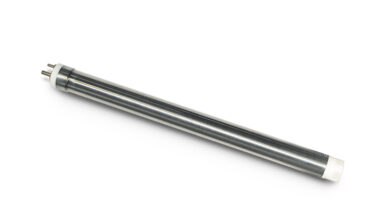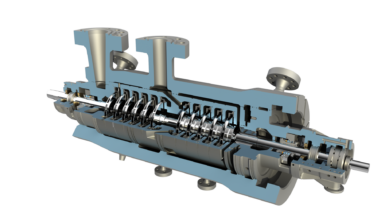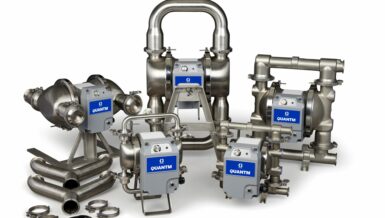Where otherwise a liquid only vaporizes at 100 °C, this now occurs at a lower pressure, at a lower temperature.
Liquids in impellers can flow at high speeds. According to Bernoulli’s Law, a pressure reduction occurs where the velocity increases. This will create vapor bubbles that can forcefully implode when they enter an area where the pressure is higher. The implosion generates a shock wave that can be heard as a sound, which can cause serious damage to the impeller and pump. The sound of a cavitating pump is very similar to pumping a liquid with pebbles and is far from pleasant. The local fluid accelerations, determined by the shape of the obstacles like impeller and diffuser vanes, play an important role in controlling cavitation. At higher temperatures the chance of cavitation increases due to the higher vapor pressure. At higher pressures the chance decreases because the margin with the vapor pressure increases.
In practice we often encounter impellers and other pump components, that have been produced with layers of exotic materials in order to prevent cavitation damage. However, at Rodelta we believe that this is mostly patchwork to mask the real problem, which often lies in the design. A good hydraulic design can prevent or limit cavitation damage in the first place. It is of course best to completely prevent cavitation from taking place, but this is not possible in many cases. For instance, when the suction pressure in the system is low, a very large and slowly rotating pump would be needed, which leads to an unnecessarily large footprint and high investment. Therefore, tradeoffs always have to be made. Pumps must be optimized for cavitation performance, while still achieving requirements like a high efficiency, broad operating range, small footprint and affordability. This is a complex task which can only be done with expert hydraulic knowledge and experience.
System layout
In addition to properly designed hydraulic components, pumps require a well-developed inlet flow to meet their total potential. A pump may not perform, or not be as reliable, as expected due to a wrongly designed system layout. When a poorly developed flow enters the pump impeller, it strikes the vanes at undesirable angles causing high local velocities and making it unable to follow the impeller passage. This can cause mechanical problems due to cavitation, vibration and performance problems due to excess turbulence and flow separation. This results in premature seal, bearing and impeller failure, high maintenance costs, high power consumption, and less-than-specified head and/or flow.
That is why at Rodelta we start from the system and not only from the pump. Please ask for the possibilities that we can offer to analyze your system, so that operational problems in your pump system can be prevented.































